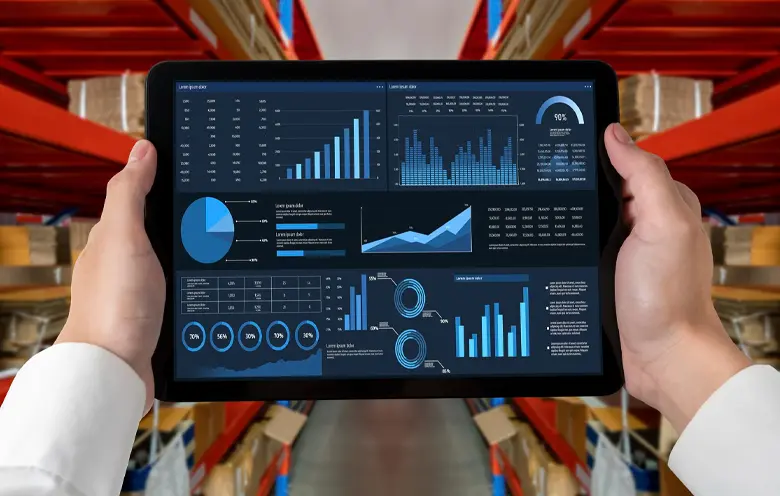Amid an unprecedented global disruption, supply chains are grappling with unparalleled complexities and continue to face a multitude of challenges:
- Less than half (43%) forty-three percent of organizations have limited to no visibility of tier-one supplier performance. (KPMG)
- Interos Annual Global Supply Chain Report reveals that global supply chain disruptions cost large companies, on average, $182 million annually.
As businesses navigate these challenges, predictive analytics emerges as a beacon of clarity and precision, offering the ability to anticipate disruptions, optimize operations, and drive strategic decision making. By utilizing the power of data-driven insights, companies can transform their supply chain operations from reactive to proactive, ensuring resilience and agility in an increasingly unpredictable world. In this blog, we will delve into common challenges of the supply chain industry and how the implementation of predictive analytics enhances supply chain services.
What is predictive analytics in supply chain?
Predictive analytics in supply chain uses statistical techniques and machine learning to examine large volumes of data. It works with both historical and real-time inputs, such as sales records, inventory levels, and supplier lead-time reports. The analysis also factors in external influences like weather forecasts and market indicators. This comprehensive data set enables models to produce accurate demand forecasts and highlight potential risks before they occur.
Using these forecasts, supply chain teams can establish reorder points well in advance and adjust stock allocations across warehouses. They can also align production plans with anticipated customer demand. This proactive approach lowers carrying costs, prevents inventory shortages, and sustains service quality even when market conditions change.
How predictive analytics works in supply chain
The process begins with four key steps: data aggregation, preparation, modeling, and insight delivery. Following this sequence helps teams identify cost-saving opportunities in inventory and improve delivery performance.
Data aggregation brings together information from point-of-sale systems, warehouse platforms, supplier logs, and external sources such as weather services and traffic feeds. Consolidating these inputs into a single repository ensures planners have a complete, up-to-date view of operations.
During preparation, analysts clean the data by correcting errors and filling gaps. They standardize formats and add features like promotional flags or regional demand indicators. This work makes sure the models have reliable information to learn from.
The third stage is modeling. Statistical techniques and machine-learning algorithms examine historical trends and external drivers to identify patterns. Time-series forecasting predicts demand over coming weeks or months. Regression analysis reveals the factors most likely to cause disruptions. Together, these methods produce demand projections and risk scores.
Finally, insight delivery turns model outputs into action. The system generates forecasts, alerts, and scenario simulations. These outputs are delivered through dashboards, scheduled reports, or automated notifications. Supply chain teams use this information to adjust reorder points, optimize production plans and refine routing. Actual performance data feeds back into the repository to refine model accuracy with each update.
Common challenges faced by the supply chain industry
Supply chain teams often spend hours reconciling stock counts and coordinating shipments to maintain smooth operations. While these tasks are essential, they drive up carrying costs, introduce scheduling risks, and erode customer satisfaction. Common challenges in this environment include:
1. Demand volatility and forecasting inaccuracy
Fluctuations in consumer demand lead to excess inventory or stockouts, both incur costs. Predicting these changes is increasingly difficult due to rapidly changing consumer preferences. Inaccurate demand forecasting makes it difficult to plan inventory levels, production schedules, and resource allocation.
2. Increase costs
Increasing costs for raw materials, transportation, labor, and compliance can erode profit margins. Supply chains must find ways to manage and optimize these costs without compromising service quality or delivery times.
3. Complexity in global supply chains
The globalization of supply chains has introduced a high level of complexity, involving multiple suppliers, manufacturers, and distributors across different countries. Managing these complex networks can be challenging, especially with varying regulations, tariffs, and trade agreements.
4. Visibility and transparency
Limited visibility into supply chain processes makes it difficult to monitor and track the movement of goods. Lack of transparency can lead to inefficiencies, increased risks of fraud, and challenges in maintaining quality control.
5. Sustainability
Increasing pressure from consumers and governments to adopt sustainable practices challenges supply chains to minimize their environmental footprint and often requires significant changes in sourcing, production, and logistics.
How predictive analytics enhances supply chain management
Predictive analytics brings all supply chain data into one view and automates demand forecasts, so teams can anticipate shifts, balance inventory and streamline logistics. This forward-looking approach cuts carrying costs, prevents delays and frees planners to focus on strategy. Below are the key areas where analytics delivers measurable improvements across the supply chain.
1. Improves demand forecasting
Predictive analytics helps businesses anticipate customer demands more accurately by analyzing historical sales data, market trends, and external factors like economic indicators and weather patterns. By improving demand forecasting accuracy, companies can reduce instances of stockouts and overstocking, ensuring optimal inventory levels and minimizing holding costs.
AI-driven forecasting can reduce supply chain errors by between 20 and 50 percent, according to McKinsey, leading to a 65 percent boost in efficiency through fewer lost sales and unavailable products.
For example, retailers can better predict which products will be in high demand during certain seasons or events, allowing for more strategic stocking decisions.
2. Enhances inventory management
With predictive analytics, companies can better understand inventory turnover rates and predict when to reorder stock. It minimizes excess inventory and storage costs ensuring products are available when needed. Predictive analytics optimizes inventory placement across multiple warehouses, reducing shipping times and costs.
For example, it is important for companies with global supply chains, where managing the flow of goods across borders and regions can be complex.
3. Proactive risk management
Predictive analytics enables companies to identify potential supply chain disruptions before they occur by analyzing data from various sources such as supplier reliability, geopolitical events, and natural disaster patterns. Businesses can assess risks and develop contingency plans allowing companies to mitigate risks, avoid costly delays, and maintain continuity in supply chain operations.
For example, if a key supplier is likely to face production issues due to political instability, companies can find alternative suppliers beforehand.
4. Optimizes transportation and logistics
Transportation is a significant cost driver in supply chain management. Predictive analytics can optimize transportation routes and schedules by analyzing traffic patterns, fuel prices, and delivery windows. It minimizes fuel consumption, reduces transportation costs, and ensures timely deliveries.
For example, predictive analytics helps in load optimization, ensuring that trucks are loaded as per their capacity, thereby reducing the number of trips required.
Suggested: How to prevent an 8% revenue loss through supply chain digitization?
5. Improves supplier relationship management
By analyzing supplier performance data, predictive analytics helps companies identify reliable suppliers and which one may pose risks. This insight allows companies to build stronger relationships with high-performing suppliers and address issues with underperforming ones. Predictive analytics helps to negotiate better terms and conditions with suppliers by providing data-driven insights into supplier performance and market trends.

Technologies used in supply chain predictive analytics
Implementing predictive analytics effectively requires a technology stack that can collect diverse data, run advanced algorithms, and deliver insights swiftly. The technologies below form the foundation of a scalable, reliable forecasting system in modern supply chains.
Cloud data platforms
Scalable data lakes and warehouses centralize sales, inventory and supplier information. These cloud platforms support large-scale storage, secure access controls, and integration with analytics tools, ensuring models have reliable and up-to-date inputs.
Machine learning frameworks
Libraries such as scikit-learn, TensorFlow and PyTorch power regression, classification and tree-based algorithms. They enable rapid prototyping and tuning of models that uncover relationships between variables and predict future outcomes.
Time-series forecasting engines
Tools like ARIMA, Facebook Prophet and LSTM neural networks specialize in identifying trends and seasonality in sequential data. They generate demand forecasts over days, weeks or months, helping teams plan production and replenishment.
Digital twin and simulation platforms
Virtual replicas of supply chain networks allow “what if” analysis under different scenarios. By simulating demand spikes or supplier disruptions, organizations can test contingency plans without risking real-world operations.
MLOps and model monitoring
End-to-end pipelines automate model deployment, versioning and performance tracking. Continuous integration, automated retraining and live monitoring ensure forecasts remain accurate as data changes over time.
IoT and real-time streaming
Sensor networks and message brokers like Kafka ingest live data from trucks, warehouses and equipment. Real-time feeds enable early detection of delays or anomalies, feeding predictions with the freshest information.
Success stories of predictive analytics for supply chain sustainability
Predictive analytics is now delivering tangible sustainability and efficiency gains across industries. The case studies that follow illustrate how improved forecasting leads to less waste, lower transport emissions and more reliable equipment uptime.
Walmart
According to a study by the University of Tennessee, the average cost of a supply chain disruption in the retail industry is $1.1 million.
Walmart, world’s largest retailer, has leveraged predictive analytics to enhance its demand forecasting and inventory management processes. By analyzing massive datasets, such as customer purchase history, seasonal trends, and local events, Walmart can accurately predict product demand at each store. This precision allows Walmart to optimize its inventory levels, reducing excess stock and minimizing the risk of stockouts. As a result, Walmart has significantly improved its supply chain efficiency, reduced waste, and enhanced customer satisfaction.
UPS
UPS, a global leader in logistics and package delivery, uses predictive analytics to optimize its delivery routes and improve fuel efficiency. By analyzing data on traffic patterns, weather conditions, and delivery locations, UPS can predict the most efficient routes for its delivery vehicles. This optimization enables to reduce fuel consumption, lower operational costs, and minimize environmental impact. It also provides more accurate delivery time estimates enhancing customer satisfaction.
DHL
According to a study by the Business Continuity Institute, the average cost of a supply chain disruption in the high-tech industry is $3.5 million.
DHL, a global leader in logistics and supply chain solutions, has successfully utilized predictive analytics to improve operational processes. By implementing predictive models, DHL has enhanced its ability to forecast demand, optimize delivery routes, and manage fleet maintenance.
For example, DHL uses predictive analytics to anticipate peak shipping times, allowing it to allocate resources more effectively and reduce delivery times. This proactive approach has improved customer satisfaction and cost efficiency. Additionally, predictive maintenance has enabled DHL to foresee and address potential vehicle breakdowns, minimizing downtime and ensuring timely deliveries.
Challenges in adopting predictive analytics and how to address them
Successful adoption of predictive analytics involves more than an out-of-the-box setup. Organizations must navigate inconsistent or siloed data, unclear success metrics and limited in-house expertise before forecasts can drive real value. The challenges and solutions below outline how to establish a solid foundation and ensure analytics delivers on its promise.
1. Data quality and integration
Challenge
Predictive analytics in supply chain relies heavily on the quality and integration of data. Many organizations face challenges due to fragmented data sources, inconsistent formats, and incomplete or inaccurate data. Poor data quality can lead to unreliable predictions, undermining the effectiveness of analytics initiatives.
Solution
To address this challenge, companies must invest in robust data management practices. It includes implementing data governance frameworks that establish data quality standards, consistency, and accuracy. Integrating data from various sources into a unified system, using data lakes or warehouses, ensures predictive models access comprehensive and reliable data. Regular data audits and cleansing processes are critical to maintaining high data quality.
2. Lack of clear ROI measurement
Challenge
Measuring the return on investment (ROI) for predictive analytics projects can be difficult, particularly when benefits are indirect or long-term. Without clear metrics, it can be challenging to justify the investment in analytics initiatives.
Solution
Companies should define clear objectives and key performance indicators (KPIs) for predictive analytics projects. Regularly tracking and reporting on these KPIs can help demonstrate the value of analytics initiatives. Companies should also consider quantitative and qualitative benefits when assessing ROI, including cost savings, efficiency gains, and improved customer satisfaction.
3. Cost and resource constraints
Challenge
Implementing predictive analytics can be costly, and requires investment in technology, infrastructure, and talent. Small and medium-sized enterprises (SMEs) may face financial constraints that limit their ability to adopt advanced analytics solutions.
Solution
To manage costs, organizations can start with pilot projects focusing on specific areas of the supply chain where predictive analytics can deliver immediate benefits. This approach allows companies to test the waters and prove the value of analytics before scaling up. Cloud-based analytics solutions can also provide a cost-effective alternative, as they offer scalable resources without the need for significant upfront investment in infrastructure.
4. Data security and privacy concerns
Challenge
With the increased use of data, concerns about data security and privacy are growing. Companies must ensure that sensitive information is protected, and data usage complies with regulations such as GDPR and CCPA.
Solution
Organizations should implement strong data security measures, including encryption, access controls, and regular security audits. Establishing clear data privacy policies and ensuring compliance with relevant regulations are also crucial. Companies can build trust with customers and partners by demonstrating commitment to data security and privacy.
Optimize operational efficiency with efficient supply chain management
Predictive analytics in supply chain stands as a transformative force, empowering supply chains not only to survive but thrive in an increasingly complex and volatile global market. By utilizing the power of data to anticipate demand fluctuations, optimize inventory, and foresee potential disruptions, businesses can achieve unparalleled agility and resilience.
As predictive analytics continues to evolve, it enables organizations to turn uncertainty into a strategic advantage and drive sustained growth. Enhance your supply chain practices with Softweb Solutions by leveraging advanced data insights and expert guidance to stay ahead in a competitive market. Talk to our experts today and learn how we can implement predictive analytics to enhance your supply chain services.
FAQs
1. Why do supply chains use predictive analytics?
Supply chains use predictive analytics to forecast demand more accurately and reduce uncertainty. By analyzing historical data and external factors, teams can anticipate stock shortages, optimize inventory levels, and improve service performance.
2. How can predictive analytics help solve modern supply chain challenges?
Predictive analytics unifies fragmented data and generates early warnings for potential disruptions such as supplier delays or sudden demand spikes. This proactive insight enables planners to adjust production schedules, reallocate stock, and maintain consistent service levels.
3. Can predictive analytics forecast supply chain success?
Predictive analytics highlights metrics such as fill rates, on-time delivery and inventory turnover that reflect overall supply chain health. Although it cannot ensure flawless operations, it delivers reliable forecasts that support strategic decision making.
4. Which aspects of the supply chain benefit most from predictive analytics?
Demand forecasting and inventory management are primary beneficiaries, reducing stockouts and excess holding costs. In addition, logistics planning, supplier performance monitoring and maintenance scheduling also gain from predictive insights.
5. How does predictive analytics improve logistics and transportation management?
By analyzing traffic patterns, fuel costs and delivery windows, predictive analytics optimizes routing and load planning. This reduces transit times, lowers transportation expenses, and enhances on-time delivery rates.
6. What are the top tools and technologies used in supply chain predictive analytics?
Cloud data platforms, machine learning frameworks, and time-series forecasting engines form the analytical core. IoT sensors, digital twins, MLOps pipelines and streaming architectures ensure real-time data flow and model accuracy.
7. How are supply chain managers using predictive analytics in decision-making?
Managers review dashboards and automated alerts to adjust reorder points, shift safety stock, and revise production plans. Scenario simulations also allow teams to test “what-if” strategies before committing resources.
8. What are the key components of a predictive analytics system?
A robust system includes data ingestion, data preparation, and feature engineering, followed by modeling and simulation. Deployment, monitoring, and feedback loops ensure models remain accurate as conditions change.
9. How can businesses implement predictive analytics in their supply chain operations?
To implement predictive analytics, businesses can start with a focused pilot project that targets a specific pain point, such as demand forecasting or route optimization. They should define clear KPIs, integrate essential data sources, choose appropriate tools and iterate on model performance.
10. What are the future trends in predictive analytics for supply chains?
Future trends include real-time edge analytics and AI-driven digital twins, which enable instant scenario testing and rapid response. Integration of prescriptive analytics and sustainability metrics will guide decision makers toward greater efficiency and stronger environmental performance.
11. What is predictive modeling in the context of supply chain analytics?
Predictive modeling uses statistical and machine learning techniques to identify relationships in historical data. These models then generate forecasts or risk scores that inform planning and operational decisions.
12. What is the difference between predictive analytics and prescriptive analytics?
Predictive analytics estimates what is likely to happen based on data patterns and trends. Prescriptive analytics goes a step further by recommending specific actions to optimize outcomes.



